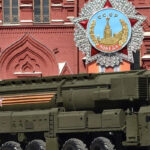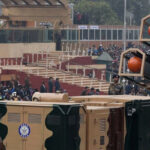By M. V. Ramana
VANCOUVER, Canada, Jun 16 2021 (IPS) – Looking through my emails for the last year, I was struck by how often the adjective “unprecedented” occurred. The term, of course, referred to the global Covid-19 pandemic. One would imagine that this unprecedented year would result in unprecedented trends in other aspects of life.
But this is not the case for preparations to kill lots of people. That for me is the message of the 2021 Yearbook from the Stockholm International Peace Research Institute (SIPRI), which documents how global military spending continued to increase, armed conflicts continued in many parts of the world, and the nine countries possessing nuclear weapons continued to modernize their arsenals.
Among these continuities is the increase in global military expenditure, which SIPRI estimates at nearly two trillion dollars in 2020, 2.6 per cent higher than the corresponding figure for 2019 and 9.3 per cent higher than in 2011.
For comparison, the World Health Organization estimates that the total government budget allocations for the Covid-19 health response is about $560 billion. This disparity in spending demonstrates the skewed priorities of the ruling elites in countries around the world.
A small fraction of these expenditures—72 billion dollars, according to the International Campaign to Abolish Nuclear Weapons (ICAN) —went to maintaining or manufacturing more of the most destructive of these military armaments, nuclear weapons.
These weapons are held by a tiny minority of states—the United States, Russia, the United Kingdom, France, China, India, Pakistan, Israel and North Korea—that buck the international desire for nuclear disarmament. (In comparison, as of June 2021, 86 states have signed the Treaty on the Prohibition of Nuclear Weapons; 54 have ratified the Treaty.)
Credit: United Nations
UN Under-Secretary-General for Disarmament Affairs Izumi Nakamitsu attends the Peace Memorial Ceremony in Hiroshima, Japan on August 6, 2020. Credit: United Nations
The SIPRI report includes a detailed update of the world’s arsenals from the Federation of the American Scientists’ Nuclear Information Project, which estimates that at the start of 2021, the nine nuclear weapon states “possessed approximately 13 080 nuclear weapons, of which 3825 were deployed with operational forces”.
The continued existence of these weapons of mass destruction demonstrates that the institutions responsible for these nuclear arsenals continue to thrive and shape public expenditures, more than three decades after the cold war was declared over.
Misdirected expenditures are hardly the only problem with these arsenals. Of much greater concern is their destructive nature. Although known from the U.S. bombardment of Hiroshima and Nagasaki in 1945, nuclear weapons technology has changed significantly since.
Many of the thirteen thousand plus nuclear weapons today would possess tens of times the explosive power of those two bombs. These nuclear weapons are to be delivered through means that are much more technically advanced than the B-29 bombers that flew to Hiroshima and Nagasaki.
The arsenals are also part of military arsenals that are bristling with a mind boggling variety of high-tech weapons. There is also the possibility that hackers could compromise the computers that control nuclear weapons or provide information to officials about impending nuclear attacks.
But there is an even more dangerous context to these weapons. Periods of great tension between many of the major nuclear powers are becoming frequent: for example, between the United States and Russia, between China and the United States, between India and China, between Pakistan and India, and between the United States and North Korea.
Relations between China and the United States, in particular, have taken a turn for worse with two recent developments. Domestically, the US Senate passed the Endless Frontier Act, which the New York Times argued was “testament to how commercial and military competition with Beijing has become one of the few issues that can unite both political parties”.
Internationally, the G7 group of rich nations have agreed to fall in line behind U.S. President Joe Biden and supported the Build Back Better World (B3W) plan, which is framed as an alternative to China’s belt and road initiative.
Analyst Andrew Lichterman points out that this competition is happening when the whole globe is “part of the capitalist circuit of trade and investment” and “there are fewer opportunities for the ‘accumulation by dispossession’ available to competing states that characterized past forms of colonialism and imperialism”.
Add to this the growth of blood and soil nationalisms in many countries. Thus, the current conjuncture is profoundly different from earlier rounds of great power competition, and the possibility of war between them should not be ruled out.
The only possible check to this collision course will be social movements. But unlike the Cold War era peace movements, the new movements will have to be multi-issue ones, tying together the struggles for arms control and nuclear disarmament with struggles for climate justice, against racial and gender injustice, for indigenous rights, and for an equitable and fair economic system that is not predicated on endless growth.
This won’t be easy, but the alternative is worse.
M.V. Ramana is the Simons Chair in Disarmament, Global and Human Security and director of the Liu Institute for Global Issues at the School of Public Policy and Global Affairs, University of British Columbia, in Vancouver, and a scholar at the Peter Wall Institute for Advanced Studies.
The link follows: https://sppga.ubc.ca/profile/m-v-ramana/
Source: http://www.ipsnews.net/2021/06/setting-stage-wars-global-pandemic/


